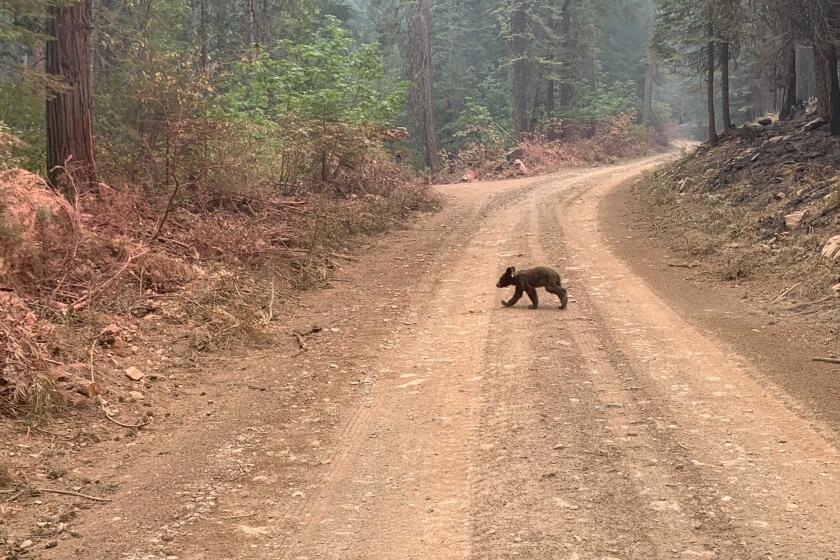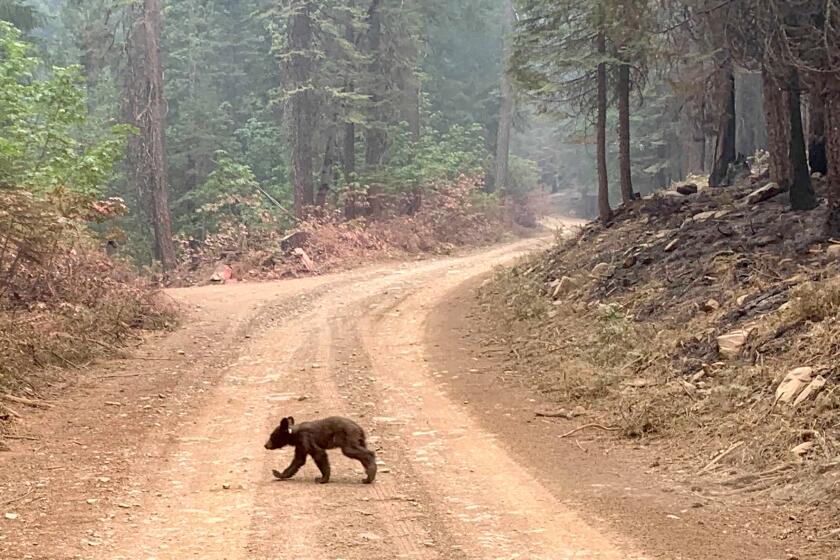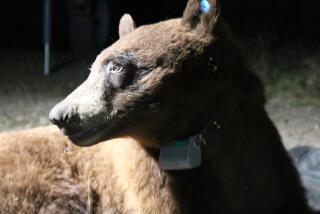Editorial: Don’t give out more chances to hunt bears in California until we know how many are out there.

- Share via
It’s hard to count black bears. They don’t travel in herds. They are generally solitary and reclusive omnivores — although they occasionally display their foraging skills when they wander into a populated area and break into a garbage can or, rarely, a house.
Bear hunting is highly regulated in California. There is a season, a quota and a rule against killing cubs or females with them. Baiting and hounding of bears is not allowed.
But despite the strict regulations, the state doesn’t have a reliable count of its bear population. And how many are out there is a concern, following the state’s disgraceful wildlife management decision a century ago to allow grizzly bears to be hunted until they were gone.
Currently, a hunter is allowed to buy a tag for one opportunity to kill one bear. However, hunters have filed a petition asking the California Fish and Game Commission to allow anyone who successfully kills one bear to get a second tag for a chance at killing another — until the number killed hits the seasonal quota of 1,700 or, possibly, up to 80% of that quota.
The state hasn’t conducted a true bear count in years.
That’s a bad idea. At meetings this week, the Wildlife Resources Committee of the California Fish and Game Commission, which sets policy, should recommend rejecting the proposal for a second tag until the state develops a management plan that includes a more reliable methodology for counting bears.
The department calculates the population by analyzing the mandatory harvest reports of hunters — a sort of exit poll. Hunters, who are required to buy a tag from the department, must report the sex of the bear killed and present the skull to wildlife officials, who extract a premolar tooth to determine age. Based on the data, wildlife officials come up with a population count.
No one thinks it’s a great model.
For years, the state Department of Fish and Wildlife has conservatively estimated the number of bears at 30,000 to 40,000. But the department’s annual report on bears killed in the 2020 hunting season presented a significantly lower estimate of 15,934, with the proviso that it could be as low as 9,771 or as high as 22,097.
Nearly a century after the California grizzly was hunted to extinction, black bears are being killed by motorists in record numbers.
The Humane Society of the U.S. has petitioned the commission to do a better count and put a moratorium on the hunt until the state changes its methodology for estimating the population and studies the effects of drought and wildfire on bears. Although the commission officially rejected that petition, it did decide that the management plan for bears needs to be updated.
The Department of Fish and Wildlife is revising the Black Bear Conservation and Management Plan and expects a draft to be ready by May. The revised plan will include an improved method for estimating and monitoring bear populations and how that information would be used to recommend any changes to the annual hunt. There are better ways to count bears, including the installation of cameras and “hair snares” that swipe fur from passing bears that can be analyzed for DNA.
The department is also going to recommend to the Wildlife Resources Committee that it urge the commission to reject the request for second tags until the new plan for surveying bears is in place.
We suggest that the commission go further. It’s true that the hunt has not reached the quota of 1,700 in a decade. Last year was no different; a little more than 1,300 bears were reported hunted and killed in 2022. But a number lower than the quota doesn’t necessarily mean there are more bears out there for the hunting. Until we get a better process for calculating the bear population, let’s pause their killing.
More to Read
A cure for the common opinion
Get thought-provoking perspectives with our weekly newsletter.
You may occasionally receive promotional content from the Los Angeles Times.












